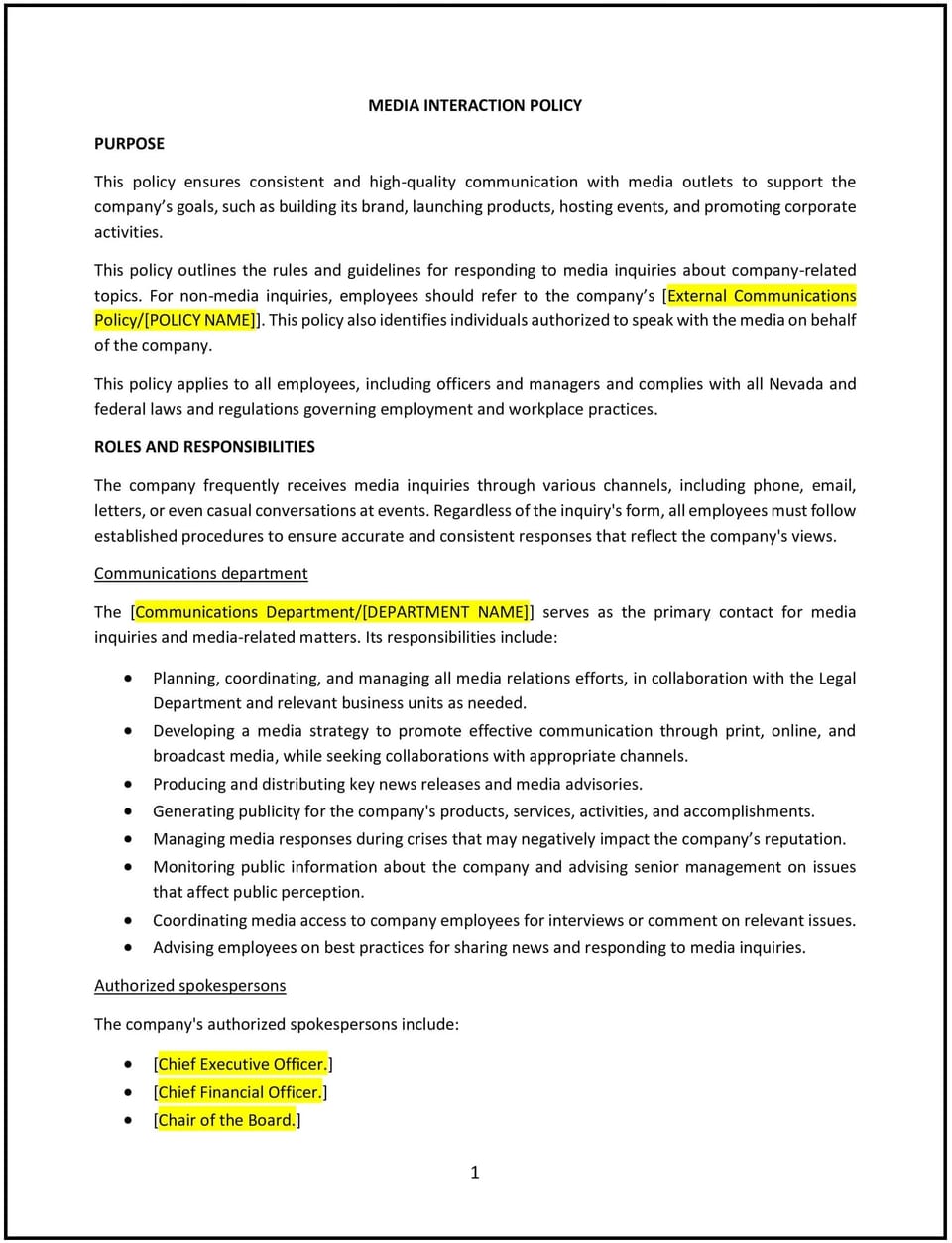Media relations policy (Nevada): Free template

Media relations policy (Nevada)
This media relations policy is designed to help Nevada businesses manage interactions with the media, ensuring consistent messaging and protecting the company’s reputation. It provides clear guidelines for responding to media inquiries, designating spokespersons, and handling press communications professionally.
By adopting this policy, businesses can maintain control over public messaging, safeguard sensitive information, and build positive relationships with the media.
How to use this media relations policy (Nevada)
- Designate spokespersons: Assign specific individuals, such as executives or communication team members, as authorized spokespersons to speak on behalf of the company.
- Establish approval processes: Require media communications, including press releases and interviews, to be approved by the designated team or spokesperson before being shared.
- Handle media inquiries: Instruct employees to direct all media inquiries to the designated spokesperson or communications team, avoiding unauthorized comments.
- Maintain confidentiality: Prohibit the sharing of confidential or sensitive company information with the media without proper authorization.
- Provide media training: Offer training for spokespersons to ensure effective communication and alignment with company messaging.
- Prepare key messages: Develop and maintain key messages or talking points that align with the company’s goals, ensuring consistency across all media interactions.
- Monitor media coverage: Regularly track media coverage to identify inaccuracies, gauge public sentiment, and respond proactively if needed.
- Respond to crises: Outline procedures for managing media relations during crises, including rapid response strategies and coordination with legal counsel if necessary.
Benefits of using this media relations policy (Nevada)
This policy provides several benefits for Nevada businesses:
- Protects the company’s reputation: Ensures consistent and professional communication with the media, safeguarding the company’s image.
- Maintains message control: Centralizes media interactions to authorized spokespersons, reducing the risk of misinformation or conflicting statements.
- Enhances media relationships: Provides clear, professional communication guidelines to foster positive relationships with journalists and media outlets.
- Reduces risk of misinformation: Ensures that only accurate, authorized information is shared with the public.
- Supports crisis management: Provides a structured approach for managing media relations during crises or sensitive situations.
Tips for using this media relations policy (Nevada)
- Communicate the policy: Share the policy with all employees, emphasizing the importance of directing media inquiries to the designated spokespersons.
- Review key messages regularly: Update key messages and talking points to reflect changes in company priorities or public perception.
- Monitor media trends: Stay informed about industry-specific media trends to identify opportunities for proactive engagement.
- Conduct periodic training: Provide regular media training for spokespersons to enhance their communication skills and ensure alignment with company goals.
- Review the policy annually: Ensure the policy remains relevant by updating it in response to changes in media practices or company operations.
Q: Who is authorized to speak to the media on behalf of the company?
A: Only designated spokespersons, such as executives or members of the communications team, are authorized to speak to the media.
Q: What should employees do if contacted by the media?
A: Employees should direct all media inquiries to the designated spokesperson or communications team and avoid making unauthorized comments.
Q: How does the company handle confidential information in media interactions?
A: Confidential or sensitive information is not shared with the media unless explicitly authorized by the company’s leadership or legal counsel.
Q: What steps are involved in approving press releases?
A: Press releases must be reviewed and approved by the designated team or spokesperson to ensure accuracy and alignment with the company’s messaging.
Q: How does the company respond to negative media coverage?
A: The company monitors media coverage and, if necessary, addresses inaccuracies or negative coverage through authorized spokespersons or legal counsel.
Q: Does the company provide media training for spokespersons?
A: Yes, the company offers regular media training for spokespersons to enhance their communication skills and ensure consistent messaging.
Q: How often should this policy be reviewed?
A: The policy should be reviewed annually or whenever there are significant changes in media practices or company operations.
Q: What is the protocol for managing media during a crisis?
A: The company follows a structured crisis communication plan, including rapid response strategies, coordination with legal counsel, and alignment of messaging with company leadership.
This article contains general legal information and does not contain legal advice. Cobrief is not a law firm or a substitute for an attorney or law firm. The law is complex and changes often. For legal advice, please ask a lawyer.


